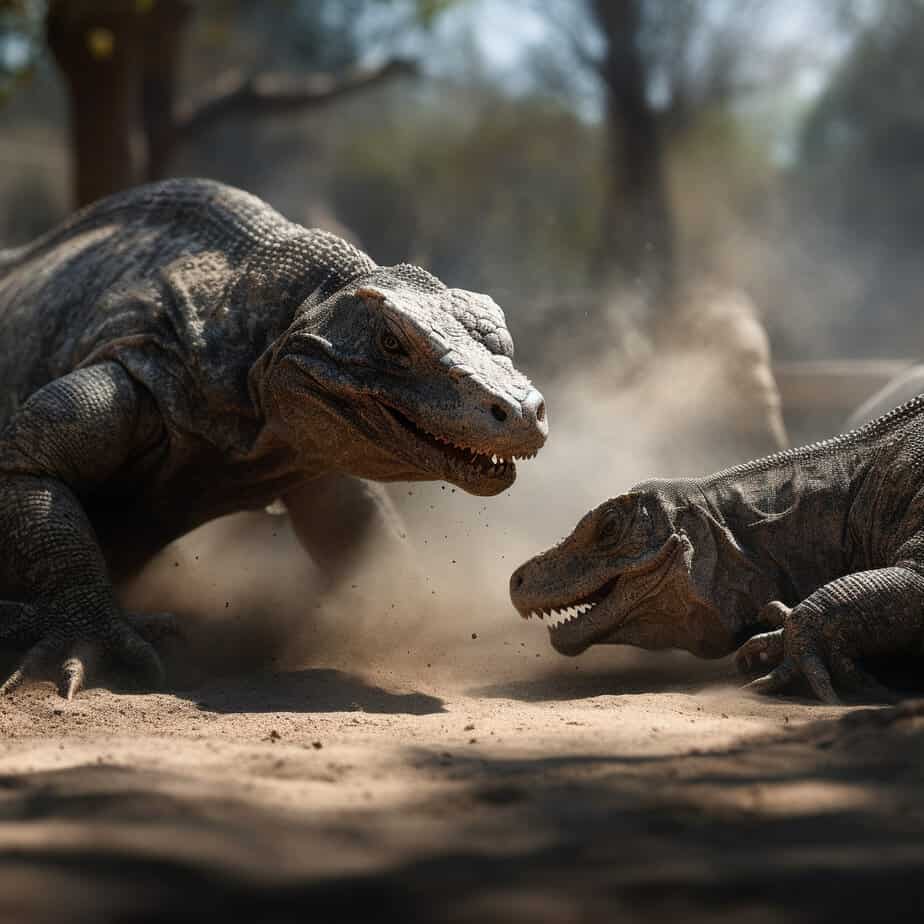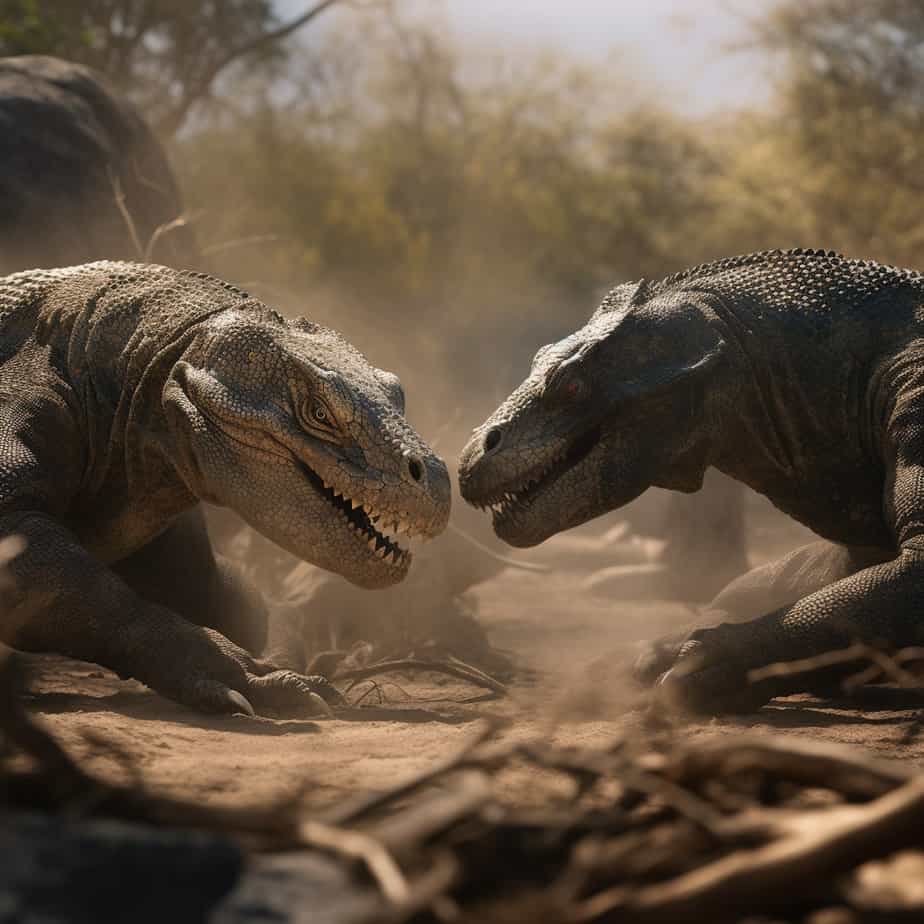The Komodo dragon, also known as Varanus komodoensis, is a fascinating and formidable creature that inhabits the Indonesian islands of Komodo, Rinca, Flores, Gili Motang, and Padar. These giant lizards are known for their impressive size, reaching up to 10 feet in length and weighing over 150 pounds. While they are primarily solitary animals, when it comes to survival and securing their territory, Komodo dragons are not afraid to engage in intense fights. These battles can be brutal and often result in serious injuries or even death. In this article, we will delve into the world of Komodo dragon fights, exploring the reasons behind these clashes, the tactics they employ, and the outcomes of these epic battles. So, let’s embark on this thrilling journey and discover the secrets of Komodo dragon fights.
Key Takeaways
- Komodo dragons engage in fierce fights to establish dominance and secure mating rights.
- These fights involve biting, slashing, and wrestling, often resulting in severe injuries or even death.
- Size and strength play a crucial role in determining the outcome of a fight.
- Komodo dragons have a unique venomous bite that weakens their opponents over time.
- Understanding the dynamics of Komodo dragon fights can provide insights into their behavior and evolutionary adaptations.
Understanding Komodo Dragons: The Giants of the Reptile World

A. The Unique Biology of Komodo Dragons
Komodo dragons, also known as Varanus komodoensis, are fascinating creatures that captivate the imagination with their sheer size and predatory prowess. These giant lizards are native to the Indonesian islands of Komodo, Rinca, Flores, Gili Motang, and Padar. Let’s delve into the unique biology of these magnificent reptiles.
1. Size and Appearance
Komodo dragons are the largest lizards in the world, with males reaching lengths of up to 10 feet and weighing around 150 pounds. Females, on the other hand, are slightly smaller, typically measuring around 6 to 7 feet in length and weighing around 100 pounds. These impressive dimensions make them a formidable presence in their natural habitat.
Their scaly skin is a mottled combination of gray, brown, and green, which helps them blend seamlessly into their surroundings. Komodo dragons have a muscular body, strong limbs, and a long, powerful tail that aids in balance and propulsion.
2. Venomous Bite
One of the most intriguing aspects of Komodo dragons is their venomous bite. While their saliva contains a potent mix of bacteria, it was long believed that the bacteria alone caused the prey’s eventual demise. However, recent research has revealed that Komodo dragons possess venom glands that produce toxic proteins, which further incapacitate their prey.
When a Komodo dragon bites its victim, the venom causes a drop in blood pressure, prevents blood clotting, and induces shock. This venomous bite, combined with the bacteria in their saliva, makes Komodo dragons formidable predators, capable of taking down animals much larger than themselves.
B. Habitat and Lifestyle: How Komodo Dragons Live
Komodo dragons are well-adapted to their unique habitat, which consists of tropical forests, savannas, and grasslands. Let’s explore how these magnificent creatures live and survive in their natural environment.
1. Solitary Predators
Komodo dragons are solitary creatures, preferring to hunt and live alone. They are highly territorial and mark their boundaries with scent markings and aggressive displays. This territorial behavior helps to minimize conflicts and maintain a stable population within their habitat.
2. Apex Predators
As apex predators, Komodo dragons have no natural predators in their ecosystem. They are at the top of the food chain and have developed remarkable hunting skills to capture their prey. Their diet mainly consists of carrion, but they are also skilled hunters, capable of taking down large mammals, birds, and even other reptiles.
3. Reproduction and Parenting
Komodo dragons reproduce through sexual reproduction, with females laying eggs. After mating, the female will dig a hole in the ground to deposit her eggs, which she then covers and abandons. The eggs hatch after a period of incubation, and the young Komodo dragons fend for themselves from the moment they emerge.
4. Conservation Status
Despite their fearsome reputation, Komodo dragons are classified as vulnerable by the International Union for Conservation of Nature (IUCN). They face numerous threats, including habitat loss, poaching, and climate change. Efforts are being made to protect their natural habitat and raise awareness about the importance of conserving these magnificent creatures.
In conclusion, Komodo dragons are truly the giants of the reptile world. Their unique biology, including their size, venomous bite, and solitary lifestyle, sets them apart from other reptiles. Understanding their habitat and lifestyle is crucial for ensuring their survival and conservation. By appreciating and protecting these incredible creatures, we can contribute to the preservation of our planet’s biodiversity.
The Intricacies of Komodo Dragon Behaviour
Komodo dragons are fascinating creatures that exhibit complex behaviors, allowing them to thrive in their natural habitat. Understanding their social structure and communication methods provides valuable insights into their behavior and interactions. Let’s delve into the intricacies of komodo dragon behavior.
A. Social Structure: Hierarchies and Dominance
Komodo dragons have a hierarchical social structure, with dominant individuals exerting control over subordinate members. This dominance hierarchy is established through aggressive displays and physical confrontations.
Within a given area, dominant komodo dragons claim territories, which they fiercely defend against intruders. These territorial disputes often result in intense battles between rival dragons. These fights can be brutal, with the dragons using their powerful jaws and sharp claws to inflict injuries on each other.
The dominant dragons have access to the best resources, such as prime basking spots and abundant prey. Subordinate dragons must navigate the social hierarchy and find their place within the community. They often have to wait for the dominant dragons to finish feeding before they can access the remains.
B. Communication: Signals and Displays in Komodo Dragons
Komodo dragons communicate through a variety of signals and displays. These behaviors play a crucial role in establishing dominance, attracting mates, and resolving conflicts.
Visual Displays: Komodo dragons use visual displays to assert dominance and intimidate rivals. They raise their bodies, stand on their hind legs, and puff out their throats to appear larger and more threatening. This display is accompanied by hissing sounds and aggressive posturing.
Chemical Communication: Komodo dragons possess a keen sense of smell and use chemical signals to communicate. They have a specialized organ called the Jacobson’s organ, located on the roof of their mouths, which allows them to detect scent particles in the air. By flicking their tongues and transferring scent particles to this organ, they can gather information about their surroundings, including the presence of other dragons.
Vocalizations: While not as common as visual displays, komodo dragons can produce a range of vocalizations. These include hisses, growls, and roars. These vocalizations are used to establish territory boundaries, attract mates, and warn off potential threats.
Body Language: Komodo dragons also communicate through body language. They may engage in head bobbing, tail wagging, and tail whipping to convey their intentions and emotions. These subtle movements can signal aggression, submission, or courtship.
Understanding the intricacies of komodo dragon behavior provides valuable insights into their survival strategies and interactions with other individuals. By studying their social structure and communication methods, researchers can gain a deeper understanding of these remarkable creatures and their place in the natural world.
The Anatomy of a Komodo Dragon Fight
A. The Role of Size and Strength
In the world of the Komodo dragon, size and strength play a crucial role in determining dominance and territorial disputes. These giant lizards, native to the Indonesian islands, engage in fierce battles to establish their dominance and secure their territory.
Komodo dragons are the largest lizards on Earth, with males reaching lengths of up to 10 feet and weighing around 200 pounds. Their massive size gives them a significant advantage in fights, allowing them to overpower smaller opponents. The sheer strength of their muscular bodies enables them to deliver powerful blows and inflict serious injuries.
B. Rituals and Displays: The Dance Before the Fight
Before engaging in combat, Komodo dragons perform elaborate rituals and displays to assert their dominance and intimidate their opponents. These rituals often involve aggressive posturing, hissing, and tail thrashing. By showcasing their size and aggression, they aim to establish their superiority and discourage potential challengers.
During these displays, Komodo dragons also use their forked tongues to pick up chemical cues from the air, detecting the presence of other dragons in the vicinity. This helps them identify potential rivals and assess the level of threat they pose.
C. The Fight: Tactics and Techniques Used by Komodo Dragons
When two Komodo dragons engage in combat, they employ a range of tactics and techniques to gain the upper hand. One common strategy is to use their powerful jaws to deliver crushing bites to vulnerable areas, such as the neck or limbs, aiming to immobilize their opponent.
Komodo dragons also utilize their sharp claws to slash and rake their opponents, causing deep wounds that can lead to severe bleeding. They rely on their agility and speed to evade attacks while simultaneously launching their own offensive maneuvers.
Despite their aggressive nature, Komodo dragons are not mindless fighters. They exhibit a level of strategic thinking, often circling their opponents to find the best angle of attack. They also rely on their acute sense of smell to track their opponents’ movements and anticipate their next move.
D. The Aftermath: Consequences of a Fight
Komodo dragon fights can have serious consequences for the combatants involved. Injuries sustained during battles can be severe, with deep wounds and broken bones being common outcomes. These injuries can lead to infections, which, in the wild, can be life-threatening.
After a fight, the victor typically claims the territory and resources of the defeated dragon. This includes access to food sources and potential mates. The defeated dragon may be forced to retreat and find a new territory, or it may face repeated challenges from other dragons seeking to exploit its weakened state.
In conclusion, Komodo dragon fights are intense and brutal affairs, where size, strength, and aggression determine the outcome. These battles are not only displays of dominance but also crucial for survival in the harsh and competitive world of the Komodo dragon.
The Purpose Behind Komodo Dragon Fights

A. Territory Disputes: The Struggle for Space
In the wild, competition for resources is a common occurrence among animals, and the Komodo dragon is no exception. These formidable reptiles engage in fierce battles to establish and defend their territories. Territory disputes among Komodo dragons primarily revolve around the struggle for space, as these creatures require large areas to hunt and find suitable mates.
Komodo dragons are native to the Indonesian islands, where their habitats are limited. As a result, they must fiercely guard their territories to ensure access to food and potential mates. These territorial battles can be intense, with dragons using their powerful jaws, sharp claws, and muscular bodies to assert dominance and claim their desired hunting grounds.
B. Mating Rivalries: The Battle for Breeding Rights
Another significant purpose behind Komodo dragon fights is mating rivalries. During the breeding season, male Komodo dragons engage in fierce combat to secure the opportunity to mate with receptive females. This battle for breeding rights is a crucial aspect of their reproductive strategy.
Male Komodo dragons will engage in aggressive displays, including head-butting, tail-whipping, and biting, to establish dominance and intimidate their rivals. These fights can be brutal, with the dragons inflicting serious injuries on each other. The winner of these battles earns the privilege of mating with the female, ensuring the survival of their genetic lineage.
C. Dominance Hierarchy: Establishing the Alpha
Komodo dragons, like many other animal species, establish a dominance hierarchy within their populations. These hierarchical structures help maintain order and reduce the frequency of physical confrontations. The fights that occur among Komodo dragons play a vital role in establishing this hierarchy and determining the alpha individuals within the population.
Through combat, Komodo dragons assess each other’s strength, agility, and overall fitness. The battles allow them to display their prowess and establish dominance over their peers. The victorious dragon earns the respect and submission of the others, solidifying its position as the alpha individual within the group.
In conclusion, Komodo dragon fights serve multiple purposes in their natural behavior. These battles help resolve territory disputes, determine breeding rights, and establish dominance hierarchies. While these fights can be intense and result in injuries, they are essential for the survival and reproductive success of these magnificent creatures. Understanding the reasons behind these fights provides valuable insights into the complex dynamics of the Komodo dragon’s behavior.
The Impact of Komodo Dragon Fights on Their Ecosystem

A. The Role of Komodo Dragons in Their Ecosystem
Komodo dragons, the largest lizards on Earth, play a crucial role in their ecosystem. These remarkable creatures are native to the Indonesian islands and are known for their impressive size, strength, and predatory nature. As apex predators, they have a significant impact on the balance of their habitat.
Komodo dragons primarily inhabit the Komodo National Park, which consists of several islands, including Komodo, Rinca, and Flores. These islands are home to a diverse range of wildlife, including deer, wild boars, water buffalo, and various bird species. The presence of Komodo dragons helps regulate the population of these prey species, ensuring a healthy and sustainable ecosystem.
These giant lizards are opportunistic hunters, capable of taking down prey much larger than themselves. They use their powerful jaws and sharp teeth to deliver a lethal bite, often ambushing their unsuspecting victims. By controlling the population of herbivores, Komodo dragons indirectly influence vegetation growth and prevent overgrazing, which can have detrimental effects on the ecosystem.
B. The Effects of Fights on Population Dynamics
Komodo dragons are solitary animals, and encounters between individuals are relatively rare. However, when territorial disputes arise or during mating season, fights between Komodo dragons can occur. These battles are intense and can result in severe injuries or even death.
During fights, Komodo dragons display aggressive behavior, showcasing their dominance and strength. They engage in combat by biting, clawing, and wrestling with each other. These fights are not only a display of power but also serve as a means of establishing dominance and securing breeding rights.
The outcome of these fights has a direct impact on the population dynamics of Komodo dragons. The dominant males, who emerge victorious, gain access to mating opportunities and pass on their genes to the next generation. This ensures the survival of the fittest and helps maintain genetic diversity within the population.
However, fights can also have negative consequences. Injuries sustained during battles can be severe, leaving the defeated individuals vulnerable to infections or other predators. This can lead to a decrease in the overall population of Komodo dragons, disrupting the delicate balance of the ecosystem.
In conclusion, Komodo dragon fights have a significant impact on their ecosystem. These battles help regulate the population of prey species, ensuring a healthy balance in the food chain. Additionally, fights play a crucial role in determining the dominant individuals who will pass on their genes, contributing to the genetic diversity of the population. However, fights can also result in injuries and potential population decline. Understanding the role and effects of Komodo dragon fights is essential for the conservation and management of these incredible reptiles and their unique habitat.
Human Interaction with Komodo Dragons: A Delicate Balance
A. The Threat of Human Encroachment on Komodo Dragon Habitats
As human populations continue to expand and encroach upon natural habitats, the delicate balance between humans and wildlife becomes increasingly strained. The Komodo dragon, a magnificent creature native to the Indonesian islands, is no exception to this struggle.
The rapid urbanization and development in the region have led to habitat loss for the Komodo dragon. Deforestation, agriculture, and infrastructure projects have all contributed to the shrinking of their natural habitats. As a result, these ancient reptiles are forced to adapt to a changing environment or face extinction.
The encroachment of humans into Komodo dragon territories not only disrupts their natural way of life but also poses significant risks to both humans and dragons. As humans venture deeper into the dragons’ domain, the likelihood of encounters and conflicts increases.
B. Conservation Efforts: Protecting the Komodo Dragon
Recognizing the importance of preserving this iconic species, conservation efforts have been implemented to protect the Komodo dragon and its natural habitats. The Indonesian government, in collaboration with international organizations and local communities, has taken steps to ensure the survival of these magnificent creatures.
One of the key initiatives is the establishment of Komodo National Park in 1980, which encompasses several islands and serves as a protected area for the dragons. This park provides a safe haven for the Komodo dragons to thrive and reproduce without the threat of human interference.
Additionally, education and awareness programs have been implemented to promote responsible tourism and minimize the negative impact on the dragons’ habitats. Visitors are educated about the importance of maintaining a safe distance and not disturbing the dragons’ natural behavior. This helps to reduce the risk of confrontations between humans and dragons.
Conservationists also conduct research to better understand the behavior and needs of the Komodo dragons. By studying their habits and monitoring their populations, scientists can develop effective conservation strategies to ensure their long-term survival.
In conclusion, the delicate balance between humans and Komodo dragons is crucial for the survival of these magnificent creatures. Human encroachment on their habitats poses a significant threat, but through conservation efforts and responsible tourism, we can protect these ancient reptiles and ensure their continued existence for generations to come. Conclusion
In conclusion, the fights between Komodo dragons are intense and fascinating displays of dominance and survival. These battles are not only a means for these powerful reptiles to establish their hierarchy and secure their territories but also a way to ensure their own survival in the harsh environment they inhabit. With their massive size, powerful jaws, and venomous bite, Komodo dragons are formidable opponents in combat. Their fights involve a combination of biting, clawing, and tail-whipping, with the goal of overpowering their opponent and asserting their dominance. These battles can be brutal and often result in injuries or even death. However, they are a crucial part of the Komodo dragon’s natural behavior and play a significant role in maintaining the balance of their ecosystem. As we continue to study and learn more about these remarkable creatures, we gain a deeper appreciation for their unique adaptations and the complex dynamics of their fights. The Komodo dragon fight is truly a spectacle to behold, showcasing the raw power and tenacity of these ancient reptiles.
Frequently Asked Questions
1. What triggers a Komodo dragon battle?
Komodo dragon battles are often triggered by territorial disputes or competition for mates. These giant lizards are highly territorial and will engage in aggressive behaviors to assert their dominance and protect their space.
2. How does a Komodo dragon assert its dominance?
A Komodo dragon asserts its dominance through physical displays of strength, such as standing on their hind legs, puffing up their body, and hissing loudly. These behaviors are often seen during Komodo dragon battles or confrontations.
3. What are the common injuries sustained in a Komodo dragon conflict?
In a Komodo dragon conflict, injuries can range from minor scratches and bites to severe wounds that can be fatal. These injuries are often inflicted by the sharp claws and teeth of the opponent.
4. How do Komodo dragons survive after a battle?
Komodo dragons have a robust immune system that helps them survive after a battle. They can recover from injuries that would be fatal to many other animals. Their survival also depends on their ability to find food and avoid further conflicts.
5. How does reptile combat differ from other wildlife conflicts?
Reptile combat, such as Komodo dragon battles, is often more physical and direct compared to other wildlife conflicts. These battles involve a lot of physical contact, biting, and scratching, unlike many other animals that rely more on displays and posturing.
6. How does a Komodo dragon attack its opponent during a fight?
During a fight, a Komodo dragon attacks its opponent by biting with its powerful jaws and slashing with its sharp claws. They also use their muscular tail as a weapon to knock down or injure their opponent.
7. How strong is a Komodo dragon?
A Komodo dragon is incredibly strong. They can take down prey much larger than themselves and are capable of overpowering humans. Their strength is a key factor in their dominance and survival in the wild.
8. How common are territorial disputes among Komodo dragons?
Territorial disputes among Komodo dragons are quite common, especially among males. These disputes often lead to violent battles as each dragon tries to assert its dominance and secure its territory.
9. How does Indonesian wildlife handle Komodo dragon aggression?
Indonesian wildlife has adapted to handle Komodo dragon aggression. Many animals avoid areas known to be inhabited by Komodo dragons, and some species have developed behaviors to deter attacks, such as grouping together for protection.
10. What is the impact of Komodo dragon rivalry on the ecosystem?
Komodo dragon rivalry plays a crucial role in maintaining the balance of the ecosystem. Their battles help control the population and ensure only the strongest and fittest individuals reproduce, contributing to the overall health and diversity of the species.




